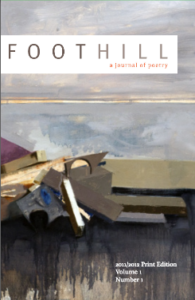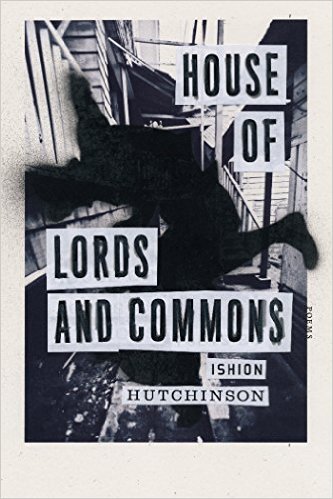Foothill Feature: Ishion Hutchinson

In 2011, Foothill: a journal of poetry began the way many ideas of whimsy do: a bunch of graduate students sat down with stacks of their favorite poetry magazines, a few cold ones, and decided to make a journal. That’s a bit of a gloss (read the full story here), but you get the idea.
The six years since Foothill’s inception have brought with it the typical slings and arrows of any journal: late nights of copy editing, reading fat packets of poetry submissions, and the logistics of getting all of our editors around the same table at the same time.
One aspect that we particularly enjoy, though, is keeping tabs on the poets that we’ve published over the years. By keeping tabs, we don’t mean that we spy on them with our state-of-the-art drone fleet (or do we?), but that we follow them on social media, read their new work, and assure them that a drink is on us if they’re passing through our neck of the woods. We’re equal parts thrilled and humbled when we see some of our past publishees find a place in the contemporary poetry landscape.

Ishion Hutchinson is one such poet. We published his poems “Her Paris,” “Essential,” and “Bicycle Eclogue” in our very first issue, that first experimental foray into then-uncharted waters. Hutchinson has published two books of poetry, Far District: Poems (Peepal Tree Press) and House of Lords and Commons (Farrar, Straus and Giroux), and he was awarded a Guggenheim Fellowship this year.

Imagine how our Foothill hearts swelled to bursting when we saw that “Bicycle Eclogue,” in a slightly different form, is part of House of Lords and Commons. Characteristic of much of the Jamaican poet’s work, “Bicycle Eclogue” explores the complex strings of tension rooted in a postcolonial dysphoria. As the title suggests, the poem marches towards a center between the pastoral and mechanical, classic and wild, investigating the speaker’s impression of the “two-wheel chariot” within a landscape of a “heat-congested city coiled to a halt in traffic.” It delivers a journey through memory that is at once tender and disarming, alternating between the harsh “my father’s cold heaven in England” and the innocence of a “simple wish” unfulfilled. Dan Chiasson of the New Yorker describes this tension as “A form of aesthetic survival in a postcolonial situation, where literary mastery and subjugation are, uncomfortably, closely aligned.” “Bicycle Eclogue” concludes as the speaker snaps a photograph of the poem’s eponym, and “hurr[ies] away.” The urgency of flight from the bicycle is a right-hook of an ending, eliciting a fearful uncertainty between classical imagery and modern tropes.

Chiasson sees aspects of the classical poetic tradition of Hutchinson’s House of Lords and Commons as prefiguring, placing him in the tradition of Whitman and Blake (the former his “eminent predecessor”), but suggests that Hutchinson’s excess does not lead to the latter’s palace of wisdom. Rather, the excesses are “misfires” or “messes” that weaken the poems. I disagree.
In identifying the genealogy of our poetic forefathers by comparing Hutchinson’s “The Orator” to Whitman’s “When I Heard the Learn’d Astronomer,” Chiasson is right about both their similarity in form and that they are poems “about poetry itself.” But even though shadows that the poetic Big Ones cast are visible, I am wary of putting Hutchinson’s poetry within their tradition. Hutchinson’s “tail-gawking, maggot rabble” and Whitman’s “mystical moist night-air” seem to me strange, if not inappropriate, bedfellows.
Chiasson sees House of Lords and Commons as “marginal doodling of a very high order, Miltonic graffiti that asserts its power by being at once polished and rash.” The power of Hutchinson’s poetry does come from the distinct contrasting nodes of being polished and rash. But this rashness, these “misfires,” do not a mess make, nor are they the result of simply not being “anthology ready.” Rather, they form a rich counterattack that resists the Great Tradition of Dead White Men by existing in it and using wildness to undermine it.
These radiating blows are pervasive in House of Lords and Commons. The collection opens with “Station”:
The train station is a cemetery.
Drunk with spirits, a man enters. I fan gnats
from my eyes to see into his face. “Father!”
I shout and stumble. He does not budge.
After thirteen years, neither snow nor train,
only a few letters, and twice, from a cell,
his hoarfrost accent crossed the Atlantic.
His mask slips a moment as in childhood,
pure departure, a gesture of smoke.
Along freighted crowds the city punished,
picking faces in the thick nest of morning’s
hard light that struck raw and stupid . . .
It recalls Ezra Pound’s “In the Station of the Metro,” and does it well. But the crowds in Hutchinson’s poem are inflicted with industry, faces are obscured by pestilences and masks, even as they are stark and clear in the hard and stupid light. It paints a much bleaker portrait than Pound’s poem (which admittedly, is difficult to do). The poem doubles the number of lines (28) to Pound’s number of words (14), as if insisting that he has grossly underrepresented modernity with Anglocentricism (which, of course, in many ways he has). The stations—Pound’s “In the Station,” Hutchinson’s “The Station,” and the train stations that represent western progress and ideology—alienate the speaker, who says “I see nothing like me” and “who am I transfixed at the bottom / of the station?” Yet, the poem overwrites “In the Station of the Metro,” a sort of double sonnet to Pound’s word sonnet, by occupying more space on the page and thereby subverting both Pound’s, and modernism’s, poetics with its own aesthetic sense of both.
Equally innovative, but via a very different method, “The Garden” is an interactive, digital, illustrated version of the poem, designed by Rocket Chair Media and illustrated by Joel Golombeck, and is available in the app store in addition to its more luddite-friendly place on page 18 of House of Lords and Commons. The app beckons the reader begin by using two fingers to rotate a white-outlined black circle on the screen. Upon entering, a watercolor map backdrops the poem. Working through it requires physical motion and creativity—the words of the poem are not always linear, and to continue reading, there’s a game-like quality and impetus to “level up” to each subsequent line, zooming, swiping, and rotating to get there. Striking illustrations—a streetlamp, trees, an obscure-faced man in bed—complement the poem with each movement. Somewhat frustratingly, there is no way to zoom out and see the poem in its entirety. You’re forced to take it in bit by bit, and work for every line, which, if mildly vexing, creates a closeness with the poem. In many ways, it also exposes the fallacy of maps—it is, in truth (and if we can’t find truth in poetry, where can we find it?) impossible to see the bird’s eye view with your feet on the ground. If there’s ever been a poem-reading experience like this, I am not aware of it. It is anything but Miltonic graffiti.
—Emily Schuck
Share